Publications
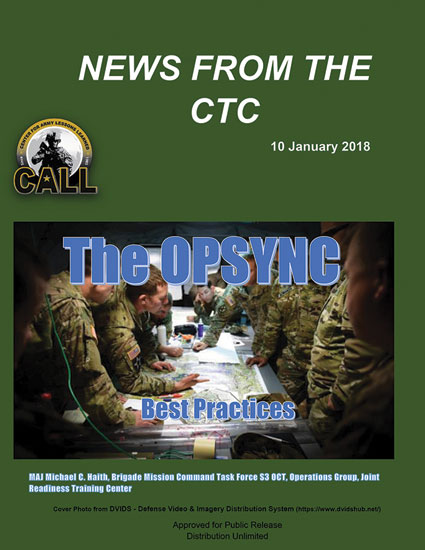 News From the CTC: The OPSYNC Best Practices
News From the CTC: The OPSYNC Best Practices
The Purpose of this document is to inform battalion and brigade leaders and staff on the importance of the operations synchronization meeting, and share lessons, best practices and examples of implementation. This document was informed by more than eighteen months of study, coaching, and mentoring from the JRTC OC/T task forces. The operations synchronization meeting (OPSYNC) is one of the central processes discussed during CTC rotations and is often the point of considerable frustration by battalion and BCT staffs. As a generation of leaders re-calibrate under the decisive action training environment (DATE), staffs are discovering the difficulty associated with harmonizing a diverse combat organization. Arriving at JRTC without developed processes and procedures necessary to synchronize the full capabilities of the BCT, units struggle to achieve mass and maintain momentum through transitions. While this deficiency is likely the result of several contributing factors, the proximate cause is the absence of an organized method to transition concepts into precise action. Ultimately, BCT staffs understand the importance of an OPSYNC, but fail to implement the process in sufficient detail necessary to withstand the complexity and turbulence of the battlefield. Succumbing to the weight of competing demands, the OPSYNC is never fully actualized as the centerpiece of the staff's daily battle rhythm.
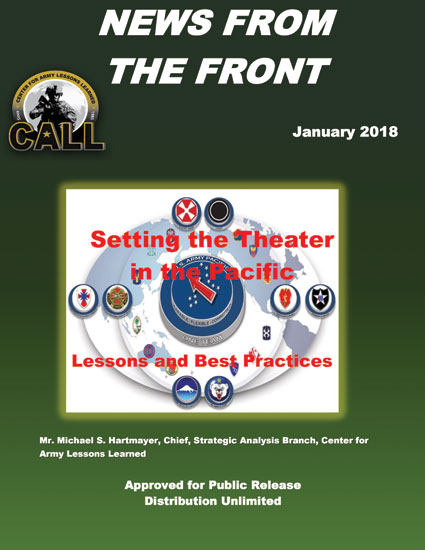 News From the Front: Setting the Theater in the Pacific
News From the Front: Setting the Theater in the Pacific
The purpose of this document is to show, in a publically releasable format, how USARPAC postured land domain capabilities to set the theater and contribute to security and stability in the Pacific region. The insights offered in this document are based on previous collections and therefore are a snapshot in time. As the situation evolves in this theater, so do the support requirements for specific operation plans, concept plans, and other requirements established in the geographic combatant commander’s (GCC’s) theater campaign plan. Therefore, this document merely provides a framework for staff to consider as they ponder and refine their own plans. Other ASCC staff’s may find this a useful model to assist in seeing themselves as they plan to set their theaters.
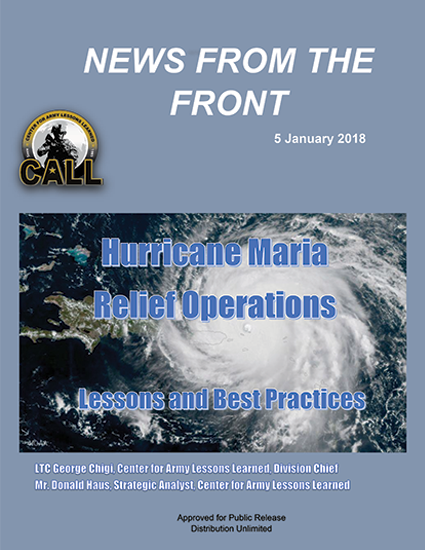 NFTF - Hurricane Maria Relief Operations
NFTF - Hurricane Maria Relief Operations
The purpose of this article is to share initial lessons and best practices observed by the units supporting the relief efforts in Puerto Rico following the landfall of Hurricane Maria. The intended audiences for the Center for Army Lessons Learned (CALL) outputs are Major Commands (MACOMs), interagency partners, and Commanders and staffs executing Defense Support of Civil Authorities (DSCA) missions.
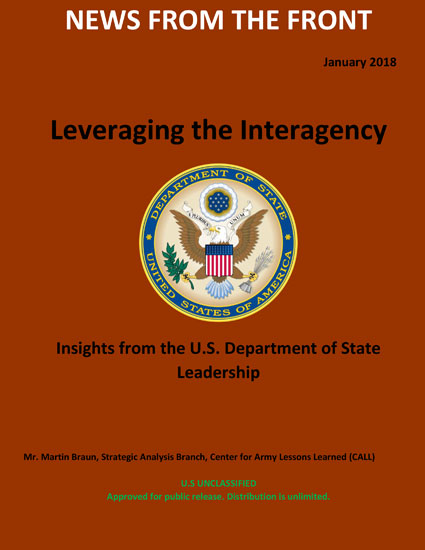 NFTF: Leveraging the Interagency - Insights from the U.S. Dept of State Leadership
NFTF: Leveraging the Interagency - Insights from the U.S. Dept of State Leadership
This Center for Army Lessons Learned (CALL) NEWS FROM THE FRONT (NFTF) provides insights, informed perspectives based on experiences, and highlights lessons and best practices provided by seasoned Department of State (DOS) personnel. The intent is to inform Army and Department of Defense (DOD) personnel at the echelons above brigade (EAB) level about valued skills that DOS personnel bring to the fight, inspire additional exploration and discussion about similarities and differences between the two Departments, and help build a stronger Interagency partnership.
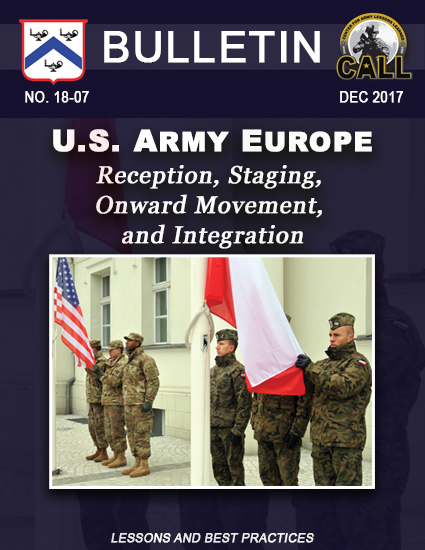 18-07 - U.S. Army Europe: Reception, Staging, Onward Movement, and Integration
18-07 - U.S. Army Europe: Reception, Staging, Onward Movement, and Integration
This bulletin provides lessons and best practices for units deploying to the U.S. Army Europe (USAREUR) area of responsibility (AOR) as well as units supporting (theater and strategic enablers) these deployments. Specifically, it chronicles the deployment of 3rd Armored Brigade Combat Team (ABCT)/4th Infantry Division (ID), located at Fort Carson, CO, to Poland in support of Operation Atlantic Resolve (OAR). The bulletin addresses questions within Army Warfighting Challenge Learning Demand No. 20, Develop Capable Formations.
 18-05 - Strategic Landpower in Europe Special Study
18-05 - Strategic Landpower in Europe Special Study
U.S. ground forces are transitioning away from a period of sustained large-scale counterinsurgencies and preparing for future conflicts. The evolution of ground operations foretell a synthesis of counterinsurgency versus traditional warfare, unconventional versus conventional, and irregular versus regular for future military engagements in Europe. Through a review of the geopolitical environment and strategic and operational theater missions, this study examines not only the role of the ASCC in theater, but also lessons and best practices that can be leveraged for future missions. The primary objective of this special study is to inform Army and joint leaders, and their staffs about the current state and future evolution of U.S. landpower in Europe. The intent is to provide a holistic overview of current landpower in Europe. Staffs, Soldiers, and leaders of USAREUR; its enablers; and the units stationed, deployed, and rotating through Europe can use this study to develop an understanding of the operational environment not available elsewhere. Army Service component commands (ASCCs) and units in other areas of responsibility may find this study a useful model for "seeing themselves." The primary target audience is the theater ground component commander and ASCC staffs. The secondary audience includes Department of Army staff, joint staff, and unified action partners.
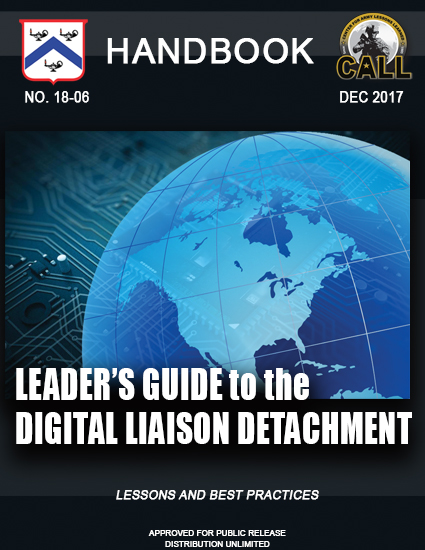 18-06 - Leader’s Guide to Digital Liaison Detachment handbook
18-06 - Leader’s Guide to Digital Liaison Detachment handbook
This handbook provides leaders and supporting staff in the operational Army with an overview of how to plan, train, and leverage the capabilities of digital liaison detachments (DLDs) that render a critical capability for mission command liaison and interoperability. Also included are operational insights from Center for Army Lessons Learned (CALL) assessment teams during exercises Anakonda 16 and Saber Guardian 17. DLDs are assigned or attached to selected theater armies and Army Service component commands. They are employed at theater armies or in support of corps and division echelons. These teams provide an Army Forces (ARFOR) commander with the capability to conduct liaison with subordinate or parallel joint and multinational headquarters within the operational area.
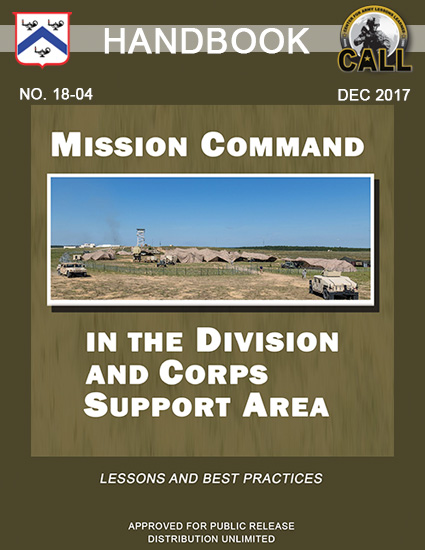 18-04 - Mission Command in the Division and Corps Support Area Handbook
18-04 - Mission Command in the Division and Corps Support Area Handbook
During warfighter exercises, it had become apparent that division and corps commanders were challenged with mission command of forces in their support areas. The commander of United States Army Forces Command directed commanders to establish a support area command post (SACP) to improve mission command. The Army’s new Field Manual (FM) 3-0, Operations (06 OCT 2017), incorporates this guidance by modifying the geographical organization of an area of operations. FM 3-0 scales down the size of the support area and adds a consolidation area. The consolidation area will be assigned to a maneuver brigade or division. This enables the maneuver enhancement brigade (MEB) to perform its traditional mission and focus efforts on operations in the support area. FM 3-0 formalizes the requirement for divisions and corps to establish a SACP (its doctrinal name, which is used throughout this handbook) to assist in controlling operations in the support and consolidation areas. This handbook provides divisions, corps, and their enablers several ways to implement recent guidance and doctrine for mission command in their support and consolidation areas. It provides the new doctrine that has been released in FM 3-0 as well as examples of how divisions and corps have employed their SACPs.
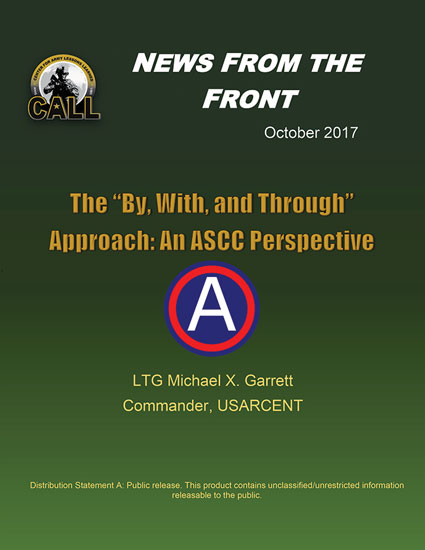 NFTF: The "By, With, Through" Approach: An ASCC Perspective
NFTF: The "By, With, Through" Approach: An ASCC Perspective
This News From The Front (NFTF) highlights the impact of unsettled definitions on the Theater Army’s support to the Joint Force Commander in the BWT prosecution of Operation Inherent Resolve. It examines the By-With-Through (BWT) from the Army Service Component Command (ASCC) perspective. It argues the point of view that the operational approach needs more analysis in order optimally employ BTW. In fact, a deeper understanding of the implications of BWT will very likely inform the future training and preparation for the US Army's Security Force Assistance Brigades (SFAB).
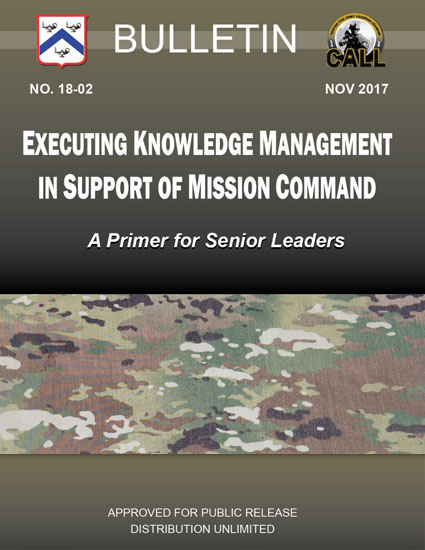 Bulletin 18-02 - Executing Knowledge Management in Support of Mission Command: A Primer for Senior Leaders
Bulletin 18-02 - Executing Knowledge Management in Support of Mission Command: A Primer for Senior Leaders
This primer was developed using lessons learned from Soldiers in the field and the Combat Training Centers, has been prepared by the Army Knowledge Management Proponent. It is intended to provide senior Army leaders a concise understanding of KM and what they can do to improve important organizational processes (e.g., the military decisionmaking process and operations process). It briefly discusses basic KM concepts, the roles of senior leaders in KM, and provides some techniques senior leaders may choose to employ in managing a KM program.
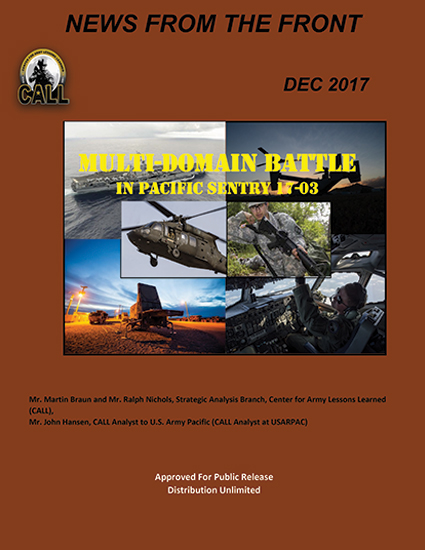 NFTF: Multi-Domain Battle in Pacific Sentry 17-03
NFTF: Multi-Domain Battle in Pacific Sentry 17-03
This News From The Front presents key leader insights, lessons, and best practices in operationalizing the concept of multi-domain battle (MDB) during exercise Pacific Sentry 17-03 as described by U.S., joint, and allied leadership and exercise participants. It provides insights from U.S. Army Pacific (USARPAC), Pacific Air Forces (PACAF), and a multinational partners' perspective (Australia [AUS]). It is the first in a series of publications focused on MDB throughout the Asia-Pacific region that will be used to inform a Center for Army Lessons Learned (CALL) Multi-Domain Battle Special Study.
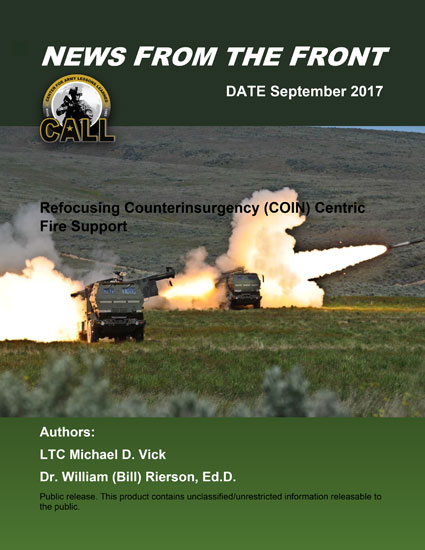 NFTF - Refocusing Counterinsurgency (COIN) Centric Fire Support
NFTF - Refocusing Counterinsurgency (COIN) Centric Fire Support
The United States and its allies must close the fire support gap to achieve a position of maneuver advantage if faced with a large-scale combat operation against a conventional peer threat. The gap must not only be closed in terms of organizing, equipping and manning. Commanders and their staffs must close this gap by refocusing the COIN-centric fire support mindset and begin to synthesize the targeting effort through the lens of a combined arms formation.

